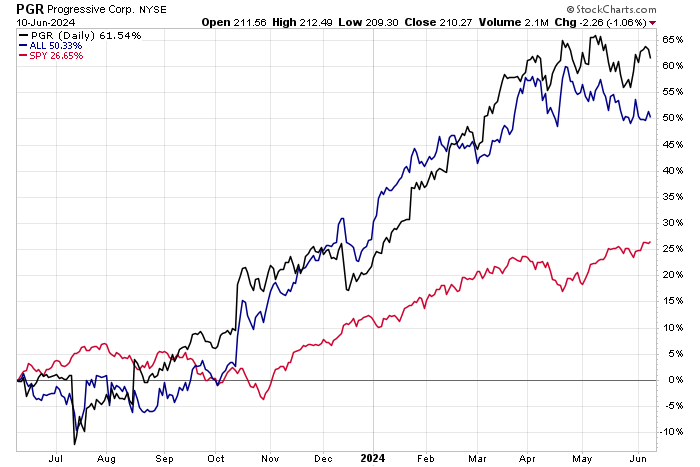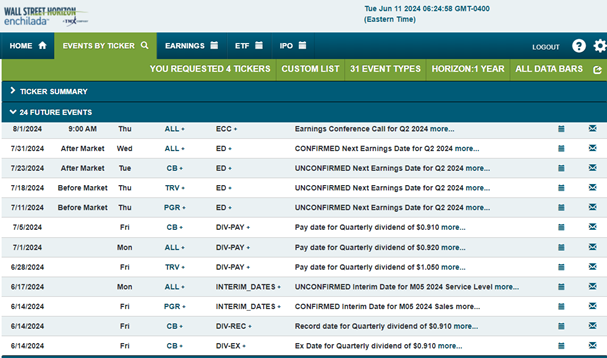-
May’s CPI report revealed a surprising decrease in the cost of motor vehicle insurance
-
Despite this, families nationwide continue to grapple with inflation’s impact on auto-related expenses
-
Upcoming financial updates from Progressive and Allstate precede the Q2 earnings season set to kick off in mid-July
Is inflation heading towards a downward slope? Yes. The Fed’s preferred measure, the CPI, has dipped to 2.7% from a peak above 7% two years back. Though still above the 2% target set by the FOMC, there’s optimism for gradual progress through the latter half of the year and beyond, possibly paving the way for interest rate cuts by Chair Powell and the Fed.
The hopeful prospect of easing policy rates, more than the actual monetary policy easing itself, drives a bullish sentiment in the markets. Strong GDP growth projections for 2023 and 2024 have also contributed positively to market momentum.
Challenges Persist in Auto Insurance Sector
Households struggling to keep up with living costs are still facing the burden of rising auto insurance costs. While overall prices aren’t shrinking, the rate of increase has slowed, offering little relief to average families grappling with escalating expenses.
One notable spike in costs has been the substantial surge in auto insurance expenses, drawing significant attention recently.
Used Car Pricing Trends vs. Insurance Premiums
Recent data indicated a decrease in car insurance CPI, the first since December 2021, yet premiums remain significantly high compared to earlier years. Factors cited for this include the increase in prices for both new and used vehicles post-pandemic, higher accident rates, costlier repairs, and more tech-equipped cars.
There’s a lag in rate adjustments by insurance firms, but with the decline in the Manheim Used Vehicle Value Index from its 2022 peak, expectations are that premium hikes may stabilize.
Insights on industry-specific developments are eagerly anticipated following Wednesday’s CPI report.
Progressive’s Strong Performance and Projected Growth
The Progressive Corporation (NYSE:) is set to release its May interim report, with analysts projecting over 100% annual earnings per share growth this year after significant advancements in 2023. Forward-looking estimates suggest low-to-mid-single-digit bottom-line growth through 2026.
While consumers bear the brunt of higher costs, Progressive’s stock continues to shine, trading comparatively lower than its historic non-GAAP price-to-earnings ratio despite a remarkable 60% rally over the last year.
Of note, net premiums written saw a 20% year-on-year decline in April, suggesting a possible shift in consumer behavior towards seeking competitive insurance rates or scaling back coverage.
Allstate’s Operational Performance and Resilience
Allstate (NYSE:) will release its monthly interim report on June 17, benefiting from recent above-trend earnings bolstered by substantial premium hikes. The company exceeded operating EPS forecasts back in April, reporting improved combined ratios despite operational challenges.
Though navigating through volatile periods, including significant weather-related losses in April, Allstate’s shares have surged 50% over the past year, reflecting investor confidence. Expectations are high ahead of the confirmed Q2 2024 earnings release scheduled for July 31.
Industry Leaders Outperforming Amid Market Volatility

Source: Stockcharts.com
Upcoming Events in the Insurance Sector
Notable industry players like Travelers and Chubb are slated to report earnings in July, adding to the market’s anticipation and setting the tone for the sector’s performance.

Source: Wall Street Horizon
Summing Up the Scenario
Families are feeling the pinch of soaring insurance costs, with auto policy premiums contributing significantly to the current inflation cycle. Amid positive trends in recent CPI reports, the forthcoming firm-specific updates are crucial in understanding the sector’s trajectory in the weeks ahead.
Disclaimer: This information is intended for informational purposes only. It highlights key trends in the insurance sector without providing specific advice or endorsements. The data presented reflects industry dynamics that may impact consumers and investors alike. Any use or reliance on this data is at the reader’s discretion.